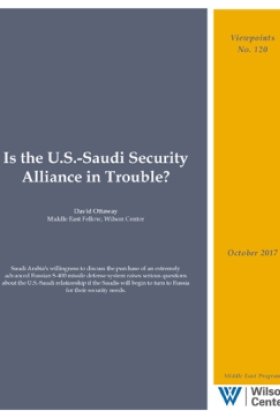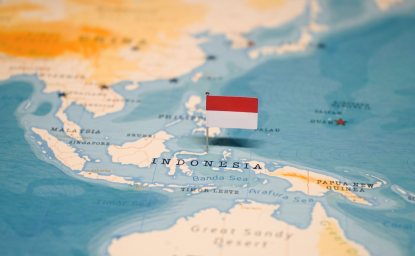Is the U.S.-Saudi Security Alliance in Trouble?


The Saudi decision to open discussions with Russia for the purchase of its highly-sophisticated S-400 missile defense system holds enormous and disruptive consequences for the U.S. security strategy toward the Arab states of the Persian Gulf, if indeed it takes place. It also raises serious questions about what is happening in the longstanding U.S.-Saudi relationship to drive the Saudis to turn to Russia for their security.
The oldest foreign alliance Saudi Arabia has is with the United States dating back to the end of World War II. Russia, by contrast, has been a traditional enemy against whose policies and proxies in the Middle East and Afghanistan which Saudi Arabia has struggled doggedly to counter often alongside the United States. Today, however, Iran has replaced Russia as the Saudi nemesis, and the advent of Donald Trump to the presidency with his fiery anti-Iranian fulminations seemed to herald the dawn of a new and far closer era in U.S.-Saudi relations after President Obama’s efforts at a rapprochement with Tehran.
The question then is: why did the Saudis, already purchasing over $200 billion in U.S. arms and delighted with Trump as president, sign a Memorandum of Understanding (MOU) with the Russians to purchase the S-400 during King Salman’s ground-breaking visit to Moscow in early October? Given Trump’s apparently highly successful visit to Saudi Arabia in May, it is even more surprising that King Salman has opened the door only four months later to Russia becoming an important new partner in the kingdom’s defense alongside the United States.
It is certainly in keeping, however, with the ever-shifting alliances in the Middle East these days as the United States retrenches, Russia re-engages and three regional powers—Iran, Turkey and Saudi Arabia—search for allies wherever in their own scramble for primacy. There are three prior examples of the Saudis threatening to upend their partnership with the United States: the Saudi-led Arab oil boycott against America at the start of the 1973 Arab-Israeli war, the purchase of Chinese intermediate-range missiles in 1986, and the late King Abdullah’s threat in 2001 to end Saudi Arabia’s special relationship with the United States.
The United States has done more than any other country to help the Arab monarchies of the Persian Gulf stand up a collective defense against their oft-declared adversary, Iran. For decades, the Pentagon has pressed the six members of the Gulf Cooperation Council (GCC) to band together under a single, integrated, U.S.-built, missile defense shield to ward off any Iranian missile attack on their vital oil and gas facilities. Most of them have already purchased American-made Patriot missiles as a first step toward such a goal. Three of them, including Saudi Arabia now, are in the process of purchasing the second layer—Theatre High Altitude Area Defense (THAAD) missiles.
But the Saudi purchase of the Russian S-400 air defense missile system would make impossible the integration and coordination of a common air defense system against Iran otherwise relying totally on American technology, experts and missiles.
It is of course possible the Saudis plan to install the Russian S-400 air defense system along their border with Yemen to cope better with increasingly longer-range missiles being fired by Iranian- backed Houthi rebels far into the kingdom. So far, Saudi Arabia has relied upon U.S.-provided Patriot missiles to intercept many but far from all of them. If installing the S-400 on the Yemen border is their intention, the Saudis would still be signaling their intent to move away from near total reliance on the United States for their security.
There are shades of present Saudi tactics in dealing with the United States in the 1988 Chinese “missile crisis” touched off by Washington’s refusal to sell the kingdom sophisticated American missiles. It began in the summer of 1985, when then Saudi ambassador to the Washington, Prince Bandar bin Sultan, flew to Beijing on the first of three secret missions to discuss the purchase of Chinese intermediate-range missiles after the Reagan administration turned down a Saudi request for nuclear-capable Pershing missiles. Only in early 1988 did the U.S. government discover that Saudi Arabia had not only purchased Chinese CSS-2 missiles but smuggled them into the kingdom without the CIA detecting their arrival. The discovery provoked a crisis of trust in U.S.-Saudi relations and brought Israel to the brink of launching an attack on Saudi Arabia.
This time, the circumstances are quite different and nothing is secret. President Trump signaled during his May visit to the kingdom that the United States was ready to sell THAAD missiles as part of a new $110 billion arms package he announced at that time. True, there was no mention of the latest American fighter aircraft, the F-35, which the Saudi Air Force covets. True, too, that it took announcement of the S-400 MOU on October 5, before the State Department quickly approved the $15 billion THAAD sale.
So what else explains the Saudi gambit to Russia? Was it just to get the Trump administration to approve the THAAD missile sale? Maybe not.
To begin with, there has been mounting Saudi frustration with repeated delays in the delivery of arms and munitions that has become much worse since Saudi Arabia led a coalition of Arab states into a war in neighboring Yemen in March 2015. The delays began during the Obama administration when the White House wanted to signal its dissatisfaction with high civilian casualties blamed primarily on errant bombings by the Saudi-led coalition.
Now it is Congress causing the delays led by Senate Foreign Relations Committee chairman Bob Corker who in June put a hold on U.S. arms sales to any of the GCC states until Saudi Arabia, Bahrain and the United Arab Emirates settled their feud with Qatar over its alleged hostile activities toward them. (So far, there is no sign of an end to this worst intra-state GCC feud ever.) In addition, there is a bipartisan bill pending in the House that would end U.S. assistance in any form to the Saudi war effort in Yemen.
Secondly, Congress passed legislation last fall during the presidential campaign to allow the families of 9/11 victims to sue the Saudi government in U.S. courts over its alleged support for some of the 15 Saudi terrorists involving in hijacking three American airliners that led to the death of nearly 3,000 Americans. The Justice Against Sponsors of Terrorism Act is at least one reason giving the Saudis pause to launch their planned $100 billion IPO on New York markets selling off five percent of Aramco, the world’s largest state oil company.
A third rationale for the Russian gambit may well be a Saudi desire to gain some influence in Moscow because it supports the Saudis’ number one regional foe, Iran. But the Russians are already selling the S-400 missile defense system to Iran, raising questions why the Saudis would want to rely on the same system defending their chief adversary.
The Saudis have dithered for nearly a decade over whether to purchase Russian arms. In the past, they offered to do so only if Russia would stop supporting Syrian President Bashar al- Assad whom they seek to overthrow or tilt toward Saudi Arabia in its cold war with Iran. Discussions began in 2008 on a $2 billion arms deal reportedly including 150 Russian T-90 tanks and 150 attack helicopters. Even then the S-400 was mooted.
While serving as the late King Abdullah’s national security adviser, Bandar made multiple trips to Moscow to negotiate a deal before resigning in April 2014. Crown Prince Mohammed bin Salman also made several trips to Moscow as defense minister starting in 2015 to discuss not only an arms purchase but Saudi-Russian cooperation on oil production cuts. The Saudi crown prince’s last trip came just one week after Trump’s visit to Riyadh in preparation for King Salman’s historic trip to Moscow in early October.
Now the Saudis are poised not only to buy the S-400 but to make Russia a partner in its new arms manufacturing project that will start with the production of Russian Kalashnikov rifles, grenade launchers and anti-tank missiles.
Clearly, there is a fundamental change underway in the Saudi sole-source reliance on the United States for its security. The day may be coming when the kingdom will host simultaneously the American THAAD, the Chinese CSS-2 and the Russian S-400 in a show of independence and a joint big power commitment to its defense.
Author

Former Washington Post Middle East Correspondent

Middle East Program
The Wilson Center’s Middle East Program serves as a crucial resource for the policymaking community and beyond, providing analyses and research that helps inform US foreign policymaking, stimulates public debate, and expands knowledge about issues in the wider Middle East and North Africa (MENA) region. Read more

Explore More
Browse Insights & Analysis
The OSCE is a Good Value for America

Israel Escalates Attacks in Gaza: What’s Next?

